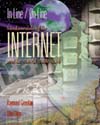 |  Inline/Online: Fundamentals of the Internet and the World Wide Web, 2/e Raymond Greenlaw,
Armstrong Atlantic State University
Ellen Hepp,
The University of New Hampshire
Privacy and Security Topics
Chapter 14 Key TermsThis glossary contains a list of important terms used in the text. Both the terms and their meanings are presented. This list is not intended to be exhaustive. For example, many of the HTML concepts are not included, but can easily be traced through the index.
| authenticate | A term meaning to verify that you are who you say you
are.
(See 632)
|  |  |  | | ciphertext | An encrypted message.
(See 553-558, 562-563, 633)
|  |  |  | | Computer Emergency Response Team (CERT) | An organization that sends out information about known security holes in software.
(See 564, 610, 634)
|  |  |  | | cryptography | The science of encoding and decoding information. See also encryption.
(See 439, 555, 634)
|  |  |  | | digital signature | A mechanism that can be used to sign an electronic document officially.
(See 561-565, 635)
|  |  |  | | double key cryptography | See public key cryptography.
(See 557-558, 562-563, 644)
|  |  |  | | firewall | A security mechanism that organizations use to protect their
intranets from the Internet.
(See 139, 565-566, 567, 636)
|  |  |  | | hash or message digest | The value computed by a hashing algorithm.
(See 559, 564, 637)
|  |  |  | | hashing algorithm | An algorithm that takes a plaintext message as input and then computes a value based on the message.
(See 558-559, 563, 637)
|  |  |  | | Local Area Network (LAN) | A privately owned computer network that is usually confined to a single building.
(See 103, 552, 611, 640)
|  |  |  | | message digest | See hash.
(See 559, 641)
|  |  |  | | Pretty Good Privacy (PGP) | An email security package developed by Phil Zimmermann. It includes authentication, compression, digital sig-nature, and privacy capabilities, and uses the RSA encryption algorithm.
(See 564, 612, 644)
|  |  |  | | prime number | A number whose only factors are 1 and itself.
(See 555-556, 644)
|  |  |  | | private key cryptography | An encryption scheme in which both the sender and the receiver share the same private key.
(See 556-557, 562-563, 644)
|  |  |  | | public key cryptography | An encryption scheme in which a message encrypted using a private key can only be decrypted using its matching public key.
(See 557-558, 562-563, 644)
|  |  |  | | Rotation 13 (ROT13) | A simple encryption scheme in which letters are rotated 13 positions further down the alphabet.
(See 553-554)
|  |  |  | | secure document | An electronic file that has been encoded so only those who know how to decode the file can read the information it contains.
(See 561, 646)
|  |  |  | | secure server | A server that sends and receives encrypted (private and
secure) messages.
(See 560, 646)
|  |  |  | | s-mail | See snail mail.
(See 3, 30, 459, 560, 647)
|  |  |  | | snail mail | Regular postal mail; also referred to as s-mail.
(See 3, 647)
|  |  |  | | sniffing | The process of tapping into a network and reading the packets that are being transmitted.
(See 561, 647)
|
|



 2002 McGraw-Hill Higher Education
2002 McGraw-Hill Higher Education